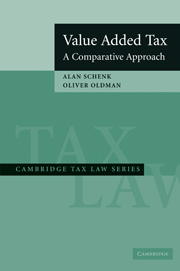Book contents
- Frontmatter
- Contents
- List of Tables, Figures, and Charts
- List of Cases
- Preface to the Revised Edition
- Value Added Tax
- 1 SURVEY OF TAXES ON CONSUMPTION AND INCOME, AND INTRODUCTION TO VALUE ADDED TAX
- 2 FORMS OF CONSUMPTION-BASED TAXES AND ALTERING THE TAX BASE
- 3 VARIETIES OF VAT IN USE
- 4 REGISTRATION, TAXPAYER, AND TAXABLE BUSINESS ACTIVITY
- 5 TAXABLE SUPPLIES OF GOODS AND SERVICES, AND TAX INVOICES
- 6 THE TAX CREDIT MECHANISM
- 7 INTRODUCTION TO CROSS-BORDER ASPECTS OF VAT
- 8 TIMING, TRANSITION AND VALUATION RULES
- 9 ZERO RATING AND EXEMPTIONS AND GOVERNMENT ENTITIES AND NONPROFIT ORGANIZATIONS
- 10 GAMBLING AND FINANCIAL SERVICES (OTHER THAN INSURANCE)
- 11 INSURANCE
- 12 INTERJURISDICTIONAL ASPECTS OF VAT IN FEDERAL COUNTRIES AND COMMON MARKETS
- 13 REAL PROPERTY
- 14 PROPOSALS FOR U.S. TAX ON CONSUMPTION
- APPENDIXES
- Index
Preface to the Revised Edition
Published online by Cambridge University Press: 06 January 2010
- Frontmatter
- Contents
- List of Tables, Figures, and Charts
- List of Cases
- Preface to the Revised Edition
- Value Added Tax
- 1 SURVEY OF TAXES ON CONSUMPTION AND INCOME, AND INTRODUCTION TO VALUE ADDED TAX
- 2 FORMS OF CONSUMPTION-BASED TAXES AND ALTERING THE TAX BASE
- 3 VARIETIES OF VAT IN USE
- 4 REGISTRATION, TAXPAYER, AND TAXABLE BUSINESS ACTIVITY
- 5 TAXABLE SUPPLIES OF GOODS AND SERVICES, AND TAX INVOICES
- 6 THE TAX CREDIT MECHANISM
- 7 INTRODUCTION TO CROSS-BORDER ASPECTS OF VAT
- 8 TIMING, TRANSITION AND VALUATION RULES
- 9 ZERO RATING AND EXEMPTIONS AND GOVERNMENT ENTITIES AND NONPROFIT ORGANIZATIONS
- 10 GAMBLING AND FINANCIAL SERVICES (OTHER THAN INSURANCE)
- 11 INSURANCE
- 12 INTERJURISDICTIONAL ASPECTS OF VAT IN FEDERAL COUNTRIES AND COMMON MARKETS
- 13 REAL PROPERTY
- 14 PROPOSALS FOR U.S. TAX ON CONSUMPTION
- APPENDIXES
- Index
Summary
Thanks to our students at Wayne State, Harvard, and Michigan law schools for their contributions to the revision of this book. Thanks to Dean Frank Wu and Wayne State University Law School, and to Georgia Clark, Director of the Wayne Law Library, and her staff for the support that made this revision possible. Thanks to our colleague Richard Ainsworth and the two anonymous readers who made helpful suggestions on how we could improve our first attempt at comparative value added tax. Thanks to Karen Kissinger for her very helpful research assistance. Thanks to our faculty assistants, Olive Hyman and Lise Berg, for their assistance with various aspects of the manuscript. Thanks to John Berger, our editor at Cambridge University Press, and Peggy Rote, Laura Lawrie, and Dianne Scent for their help in the process of converting our manuscript to final text.
The cutoff date for this book generally was March 31, 2006, although we have included some material published after that date. In particular, we included some European Court of Justice cases, including those covering the Italian subnational tax (IRAP) and some VAT-abusive transactions. This book is not intended to be exhaustive. It therefore does not include all significant cases in all countries or even all English-speaking countries. It is designed to illustrate, analyze, and explain the principal theoretical and operating features of value added taxes, including their adoption and implementation.
- Type
- Chapter
- Information
- Value Added TaxA Comparative Approach, pp. xxxiii - xxxivPublisher: Cambridge University PressPrint publication year: 2007



